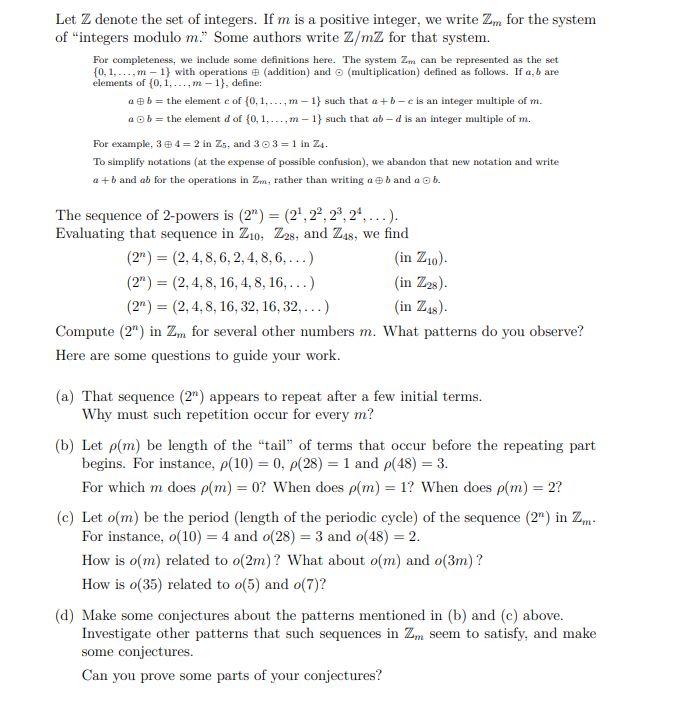(a) That sequence (2") appears to repeat after a few initial terms. Why must such repetition occur for every m? (b) Let p(m) be length of the "tail" of terms that occur before the repeating part begins. For instance, p(10) = 0, p(28) = 1 and p(48) = 3. For which m does p(m) = 0? When does p(m) = 1? When does p(m) = 2? (c) Let o(m) be the period (length of the periodic cycle) of the sequence (2") in Zm- For instance, o(10) = 4 and o(28) = 3 and o(48) = 2. How is o(m) related to o(2m)? What about o(m) and o(3m)? How is o(35) related to o(5) and o(7)?
(a) That sequence (2") appears to repeat after a few initial terms. Why must such repetition occur for every m? (b) Let p(m) be length of the "tail" of terms that occur before the repeating part begins. For instance, p(10) = 0, p(28) = 1 and p(48) = 3. For which m does p(m) = 0? When does p(m) = 1? When does p(m) = 2? (c) Let o(m) be the period (length of the periodic cycle) of the sequence (2") in Zm- For instance, o(10) = 4 and o(28) = 3 and o(48) = 2. How is o(m) related to o(2m)? What about o(m) and o(3m)? How is o(35) related to o(5) and o(7)?
Elements Of Modern Algebra
8th Edition
ISBN:9781285463230
Author:Gilbert, Linda, Jimmie
Publisher:Gilbert, Linda, Jimmie
Chapter1: Fundamentals
Section1.1: Sets
Problem 10E
Related questions
Question
Please give a mathematical solution step-by-step, including all the patterns, conjectures, proofs and please take into consideration all the parts a, b, c, d in the problem

Transcribed Image Text:Let Z denote the set of integers. If m is a positive integer, we write Z, for the system
of "integers modulo m." Some authors write Z/mZ for that system.
For completeness, we include some definitions here. The system Zm can be represented as the set
{0, 1,..., m – 1} with operations e (addition) and o (multiplication) defined as follows. If a, b are
elements of (0, 1,..., m – 1}, define:
a eb = the element e of (0, 1,..., m – 1} such that a +b - e is an integer multiple of m.
a ob = the element d of (0, 1,..., m – 1} such that ab – d is an integer multiple of m.
For example, 3e 4 = 2 in Z5, and 303 = 1 in Z4.
To simplify notations (at the expense of possible confusion), we abandon that new notation and write
a +b and ab for the operations in Zm, rather than writing ae b and a o b.
The sequence of 2-powers is (2") = (2', 2°, 2°, 2ª, .).
Evaluating that sequence in Z10, Z2s, and Z48, we find
(2") = (2, 4, 8, 6, 2, 4, 8, 6, ...)
(in Z10).
(in Z2s).
(in Z4s).
(2") = (2,4, 8, 16, 4, 8, 16, ...)
(2") = (2, 4, 8, 16, 32, 16, 32, ...)
Compute (2") in Z„ for several other numbers m. What patterns do you observe?
Here are some questions to guide your work.
(a) That sequence (2") appears to repeat after a few initial terms.
Why must such repetition occur for every m?
(b) Let p(m) be length of the "tail" of terms that occur before the repeating part
begins. For instance, p(10) = 0, p(28) = 1 and p(48) = 3.
For which m does p(m) = 0? When does p(m) = 1? When does p(m) = 2?
(c) Let o(m) be the period (length of the periodic cycle) of the sequence (2") in Zm-
For instance, o(10) = 4 and o(28) = 3 and o(48) = 2.
How is o(m) related to o(2m)? What about o(m) and o(3m)?
How is o(35) related to o(5) and o(7)?
(d) Make some conjectures about the patterns mentioned in (b) and (c) above.
Investigate other patterns that such sequences in Zm seem to satisfy, and make
some conjectures.
Can you prove some parts of your conjectures?
Expert Solution
This question has been solved!
Explore an expertly crafted, step-by-step solution for a thorough understanding of key concepts.
Step by step
Solved in 3 steps

Recommended textbooks for you

Elements Of Modern Algebra
Algebra
ISBN:
9781285463230
Author:
Gilbert, Linda, Jimmie
Publisher:
Cengage Learning,

Linear Algebra: A Modern Introduction
Algebra
ISBN:
9781285463247
Author:
David Poole
Publisher:
Cengage Learning

Elementary Linear Algebra (MindTap Course List)
Algebra
ISBN:
9781305658004
Author:
Ron Larson
Publisher:
Cengage Learning

Elements Of Modern Algebra
Algebra
ISBN:
9781285463230
Author:
Gilbert, Linda, Jimmie
Publisher:
Cengage Learning,

Linear Algebra: A Modern Introduction
Algebra
ISBN:
9781285463247
Author:
David Poole
Publisher:
Cengage Learning

Elementary Linear Algebra (MindTap Course List)
Algebra
ISBN:
9781305658004
Author:
Ron Larson
Publisher:
Cengage Learning
